 W
WThe Trecento refers to the 14th century in Italian cultural history.
 W
WThe cultural and artistic events of Italy during the period 1400 to 1499 are collectively referred to as the Quattrocento from the Italian word for the number 400, in turn from millequattrocento, which is Italian for the year 1400. The Quattrocento encompasses the artistic styles of the late Middle Ages, the early Renaissance, and the start of the High Renaissance, generally asserted to begin between 1495 and 1500.
 W
WThe cultural and artistic events of Italy during the period 1500 to 1599 are collectively referred to as the Cinquecento, from the Italian for the number 500, in turn from millecinquecento, which is Italian for the year 1500. Cinquecento encompasses the styles and events of the High Italian Renaissance, Mannerism and some early exponents of the Baroque-style.
 W
WAgostino Barbarigo was Doge of Venice from 1486 until his death in 1501.
 W
WAdriana Basile was an Italian composer and singer.
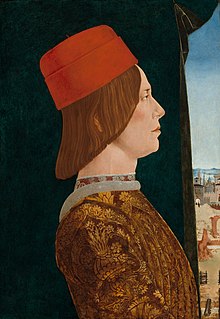 W
WGiovanni II Bentivoglio was an Italian nobleman who ruled as tyrant of Bologna from 1463 until 1506. He had no formal position, but held power as the city's "first citizen." The Bentivoglio family ruled over Bologna from 1443, and repeatedly attempted to consolidate their hold of the Signoria of the city.
 W
WMaddalena Casulana was an Italian composer, lutenist and singer of the late Renaissance. She is the first female composer to have had a whole book of her music printed and published in the history of western music.
 W
WPasquale Cicogna was the Doge of Venice from 1585 to 1595. He supported the claim of Henry of Navarre to the French throne, and convinced Pope Sixtus V to support Henry in exchange for his conversion to Catholicism.
 W
WPope Clement VII, born Giulio di Giuliano de' Medici, was head of the Catholic Church and ruler of the Papal States from 19 November 1523 to his death on 25 September 1534. “The most unfortunate of the Popes,” Clement VII’s reign was marked by a rapid succession of political, military, and religious struggles—many long in the making—which had far-reaching consequences for Christianity and world politics.
 W
WAndrea Doria was a Genoese statesman, condottiero and admiral, playing a key role in the Republic of Genoa during his lifetime.
 W
WGiovanni Andrea Doria, also known as Gianandrea Doria, (1539–1606), was an Italian admiral from Genoa.
 W
WBeatrice d'Este, was duchess of Bari and Milan by marriage to Ludovico Sforza. She was reputed as one of the most beautiful and accomplished princesses of the Italian Renaissance. A member of the Este family, she was the younger daughter of Ercole I d'Este and the sister of Isabella d'Este and Alfonso d'Este.
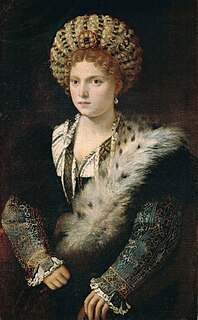 W
WIsabella d'Este was Marchioness of Mantua and one of the leading women of the Italian Renaissance as a major cultural and political figure. She was a patron of the arts as well as a leader of fashion, whose innovative style of dressing was copied by women throughout Italy and at the French court. The poet Ariosto labeled her as the "liberal and magnanimous Isabella", while author Matteo Bandello described her as having been "supreme among women". Diplomat Niccolò da Correggio went even further by hailing her as "The First Lady of the world".
 W
WMarco da Gagliano was an Italian composer of the early Baroque era. He was important in the early history of opera and the development of the solo and concerted madrigal.
 W
WCecilia Gallerani, born in Siena, Italy, was the favourite and most celebrated of the many mistresses of Ludovico Sforza, known as Lodovico il Moro, Duke of Milan. She is best known as the subject of Leonardo da Vinci's painting The Lady with an Ermine. While posing for the painting, she invited Leonardo, who at the time was working as court artist for Sforza, to meetings at which Milanese intellectuals discussed philosophy and other subjects. Cecilia herself presided over these discussions.
 W
WMaffeo Gherardi (1406–1492) was an Italian Roman Catholic bishop and cardinal.
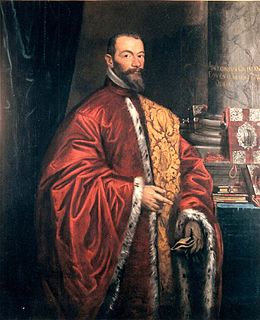 W
WAntonio Grimani was the Doge of Venice from 1521 to 1523.
 W
WAndrea Gritti was the Doge of Venetian Republic from 1523 to 1538, following a distinguished diplomatic and military career.
 W
WLawrence Justinian is venerated as a saint by the Catholic Church. He was a canon regular who was appointed as a bishop and became the first Patriarch of Venice.
 W
WLeonardo Loredan or Loredano of the Loredan family was the 75th doge of the Venetian Republic from 1501 until his death. His dogeship was one of the most important in the history of Venice.
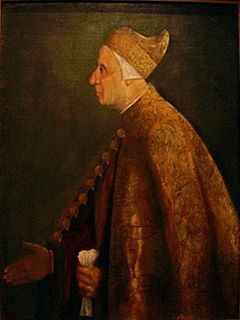 W
WNicolò Marcello was the 69th Doge of Venice, elected in 1473. He held office for a short period, from 13 August 1473 to 1 December 1474. Said to have been inspired by a previous painting dating from the 15th century, Titian painted Nicolo Marcello's portrait long after his death.
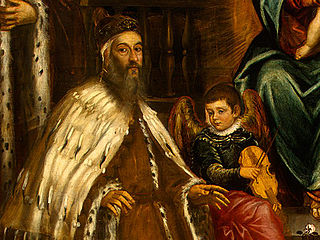 W
WThere were three Doges, and many other prominent Venetians, called Alvise Mocenigo. Alvise I Mocenigo was doge of Venice from 1570 to 1577.
 W
WGiovanni Ser di Mocenigo, Jr., Pietro Mocenigo's brother, was doge of Venice from 1478 to 1485. He fought at sea against the Ottoman Sultan Mehmed II and on land against Ercole I d'Este, duke of Ferrara, from whom he recaptured Rovigo and the Polesine. He was interred in the Basilica di Santi Giovanni e Paolo, a traditional burial place of the doges. His dogaressa was Taddea Michiel, who was to be the last dogaressa to be crowned in Venice until Zilia Dandolo in 1557, almost a century later.
 W
WPietro Mocenigo (1406–1476) was doge of Venice from 1474 to 1476.
 W
WGuido Panciroli or Pancirolli was a sixteenth-century Italian antiquarian, historian, jurist and law professor at Ferrara, Padua and Turin. In his time he was renowned as a legal scholar, teaching students who came from all around Europe. Posthumously, he was well known for his innovative comparative survey, Rerum memorabilium, iam olim deperditarum, that brought attention to the loss of knowledge since the ancient world.
 W
WBenedetto Pesaro was a Venetian nobleman who served as commander-in-chief of the Venetian navy from 1500 to 1503. He is notable for his military successes during the Second Ottoman–Venetian War.
 W
WGiovanni Maria Trabaci was an Italian composer and organist. He was a prolific composer, with some 300 surviving works preserved in more than 10 publications; he was especially important for his keyboard music.
 W
WNicolò Tron was the 68th Doge of Venice, reigning from 1471 to 1473.
 W
WAndrea Vendramin served as Doge of Venice, 1476–78, at the height of Venetian power, the only member of the Vendramin family to do so. His mother, Maria Michiel, and his wife Regina Gradenigo, both came from Dogal families. He had served as Venetian Procurator in Rome, and his brief reign was largely concerned with the end of the Second Turkish–Venetian War. He probably died of plague.
 W
WAntonio "Zacara" da Teramo was an Italian composer, singer, and papal secretary of the late Trecento and early 15th century. He was one of the most active Italian composers around 1400, and his style bridged the periods of the Trecento, ars subtilior, and beginnings of the musical Renaissance.